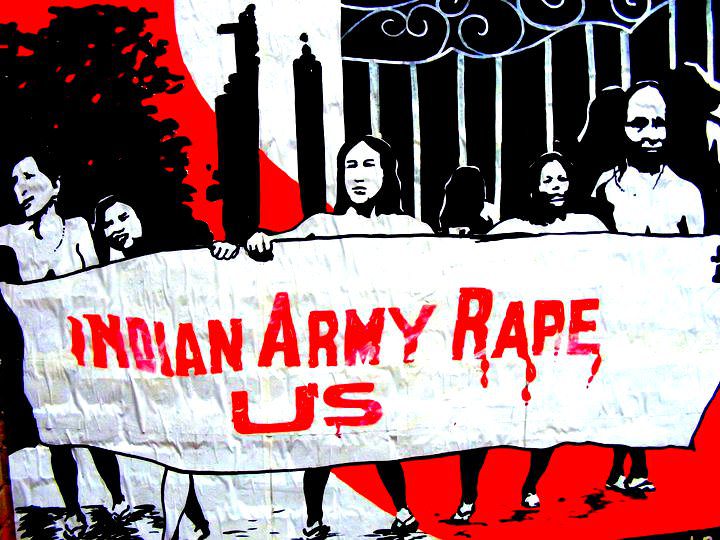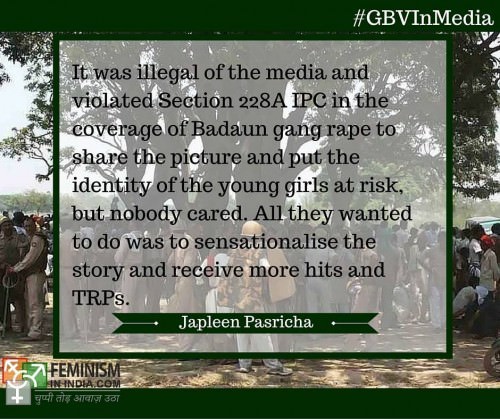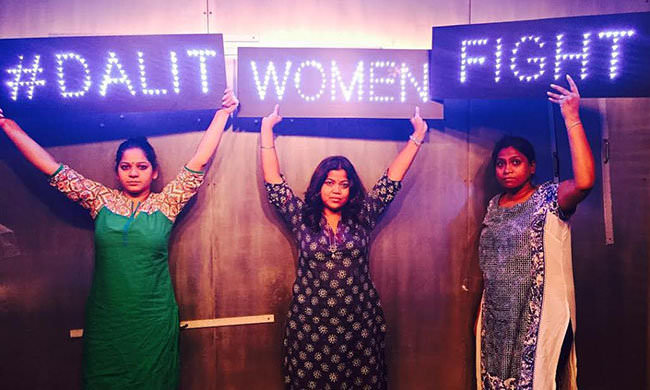This article is part of the #GBVInMedia campaign for the 16 Days Of Activism global campaign to end gender-based violence. #GBVInMedia campaign analysis how different kind of mainstream media (mis)represents/reports gender-based violence and broadens the conversation from violence against women to violence against people from the queer community, caste-based violence and violence against people with disabilities. Join the campaign here.
When we talk about gender-based violence, we sometimes seem to forget that violence doesn’t happen in isolation. There are a lot of factors or rather intersections that contribute to it. Even gender-based violence has many facets, it happens to women with disabilities, lesbian and bisexual women, gay men, trans* people among others. In India, there is another intersection, that is of caste. And anyone who says caste system doesn’t exist anymore obviously lives under a rock or is maybe Jon Snow (for GOT fans)! This article attempts to analyse mainstream news media’s reportage and society’s reaction in general to the continuing onslaught of sexual violence against the Dalit women and girls.
When Phoolan Devi’s case came to limelight various books were written on her life as well as a film called Bandit Queen directed by Shekhar Kapoor was made. However, an important point to be noted here is that the director of the movie, Shekhar Kapur, did not even think it is necessary to seek Phoolan Devi’s consent before making a movie based on her life. Author-activist Arundhati Roy in her film review entitled, ‘The Great Indian Rape Trick’, questioned the right to “restage the rape of a living woman without her permission“, and charged Shekhar Kapur with exploiting Phoolan Devi and misrepresenting both her life and its meaning.
Mathura, a young tribal girl, was raped by two policemen on the compound of Desai Ganj Police Station in Chandrapur district of Maharashtra on 26 March 1972. The judgment returned found the defendants not guilty. It was stated that because Mathura was “habituated to sexual intercourse,’ her consent was voluntary; under the circumstances only sexual intercourse could be proved and not rape“. On appeal the Nagpur bench of the Bombay High Court set aside the judgment of the Sessions Court, and sentenced the accused to one and five years imprisonment respectively.
However, in September 1979 the Supreme Court of India justices Jaswant Singh, Kailasam and Koshal in their judgement on Tukaram vs. State of Maharashtra reversed the High Court ruling and again acquitted the accused policemen. The Supreme Court held that Mathura had raised no alarm; and that there were no visible marks of injury on her thereby suggesting no struggle and hence no rape. The judge noted, “Because she was used to sex, she might have incited the cops (they were drunk on duty) to have intercourse with her“. After the Supreme Court acquitted the accused, there was public outcry and protests, which eventually led to amendments in Indian rape law via The Criminal Law (Second Amendment) Act 1983.
Bhanwari Devi is a dalit social-worker from Bhateri, Rajasthan, who was gang raped in 1992 by higher-caste men angered by her efforts to prevent an early marriage in their family. She was ill-treated by the police and the court acquitted the accused. A state MLA organised a victory rally in the state capital Jaipur for the five accused who were now declared not guilty, and the women’s wing of his political party attended the rally to call Bhanwari a liar. She was ostracised by members of her own caste and community and when her mother died, her brothers did not even allow her to participate in the funeral.
On 25 September 1992, the Rajasthan Patrika carried a small news item stating that a woman from Bhateri village had registered a FIR in Bassi thana (police station) alleging gang rape. On 2 October 1992, the Rajasthan Patrika carried an editorial article Kroor Hadsa (brutal incident) condemning the incident. However, Bhanwari Devi was accused of fabricating the entire incident by the rapists and their supporters, and faced public humiliation in her village. She refused monetary compensation to discourage such allegations.
Thangjam Manorama was picked up from her home by the Indian paramilitary unit, 17th Assam Rifles in July 2004 on allegations of being associated with People’s Liberation Army. The next morning, her bullet-ridden corpse was found in a field. An autopsy revealed semen marks on her skirt confirming rape and murder. Five days after the killing, around 30 middle-aged women walked naked through Imphal to the Assam Rifles headquarters, shouting, “Indian Army, rape us too… We are all Manorama’s mothers.” The fight against AFSPA continues.

In 2006, the Khairlanji massacre took place where four members of the Bhotmange family belonging to a Dalit caste were murdered by members of the politically dominant Kunbi caste. The women of the family were paraded naked in public and gang-raped before being murdered. The Indian media did not cover this incident until the Nagpur riots by the Dalits.
Soni Sori, a young tribal teacher from Chattisgarh was brutally raped in custody in 2011 and tortured with stones put into her private parts. However, instead of putting her rapists behind bars, Soni was arrested on charges of being a link between Maoists and the Essar group. The Chhattisgarh government submitted to the Supreme Court of India that the entire allegation was being orchestrated by certain vested interests to malign the Chhattisgarh Police. The police also denied the charges of torture. ADG (Naxal) Ramnivas said that she had slipped in the bathroom and had injured herself.
“Giving electric shocks, stripping me naked, shoving stones inside me – is this going to solve the Naxal problem,” she once asked in a letter to the Supreme Court.
She was refused by the All India Institute of Medical Sciences, but was later admitted for treatment. She was found to be suffering from severe blisters in her genital area, and a government inquiry was instituted to learn why the hospital had initially refused her. Rahul Pandita of OPEN wrote that “there is good reason to believe that the stories in circulation about her are a complex web of lies and falsehood systematically spread over the past two years by the state machinery“, and compared the case to George Orwell’s novel 1984. The Indian Express wrote of the case that “Sori’s story over the past two years is that of a woman who was exploited both by the police and the Maoists—some would say she let them use her—and now by her activist friends.”
On 27 May 2014, two teenage girls were gang raped and murdered in Badaun, Uttar Pradesh, India. After an extensive investigation, CBI concluded that there was no gang rape and the rapists were released. It was widely reported in the press in India as well as overseas. It did not take the media even a single minute to post the picture of the two girls hanging from a tree. The picture was shared widely on social media, though some criticised and refused to share it or at least put a trigger warning before, many enjoyed the voyeurism. It was illegal of the media and violated Section 228A IPC in the coverage of Badaun gang rape to share the picture and put the identity of the young girls at risk, but nobody cared. All they wanted to do was to sensationalise the story and get more hits and TRPs.

After outrage on Twitter, a candle-light vigil in Delhi and a letter published on Savari with regard to the blatant violation of the rape-shield laws, as well as the abuse of children’s rights, in the media coverage of the Badaun gang rape and murder, some media houses changed the pictures and/or blurred the girls’ faces. However, the damage was done.
The Badaun case threw into focus four rape survivors from Bhagana village in Hisar, Haryana, who had been protesting at Jantar Mantar in New Delhi. However, they couldn’t even protest in peace. A few days later Delhi Police forcibly evicted the Bhagana survivors’ and other tents and warned the protesters to vacate Jantar Mantar by noon. At Hisar mini secretariat, Bhagana’s dalit families were evicted in the same manner.
The recent attacks on Dalit people in India where a man was lynched for eating ‘beef’, Dalit children were burned alive and a Dalit family was stripped naked show how we as a country are regressing. General V.K Singh, Union Minister of State for External Affairs said, “For everything…like if somebody throws a stone at a dog, then the government is responsible…it is not like that“. The media was hesitant to report on the Dalit family who was stripped naked and beaten in Dankaur.
The casteist nature of most hierarchies where upper caste upper class people are still in power hinders from marginalised groups be it dalits, adivasis or tribals to be represented in a sensitive manner without exoticising on the ‘other’. Below are some references which are brilliant reads on violence against dalit women and representation of caste-based violence in the media.
References:
i. Preliminary Report: National Tribunal Violence against Dalit Women, Savari.
ii. Dalit Women Fight, International Dalit Solidarity Network
iii. Violence against Dalit Women, Legally India
iv. Violence of Silence: Brahmanic Media Constructions of Caste and Gender, Dr. Smita Patil
v. Attacks on Dalit Women: A Pattern of Impunity, Human Rights Watch
Featured Image Credit: Thenmozhi Soundararajan, Dalit Women Fight
About the author(s)
Japleen smashes the patriarchy for a living! She is the founder-CEO of Feminism in India, an award-winning digital, bilingual, intersectional feminist media platform. She is also an Acumen Fellow, a TEDx speaker and a UN World Summit Young Innovator. Japleen likes to garden, travel, swim and cycle.




